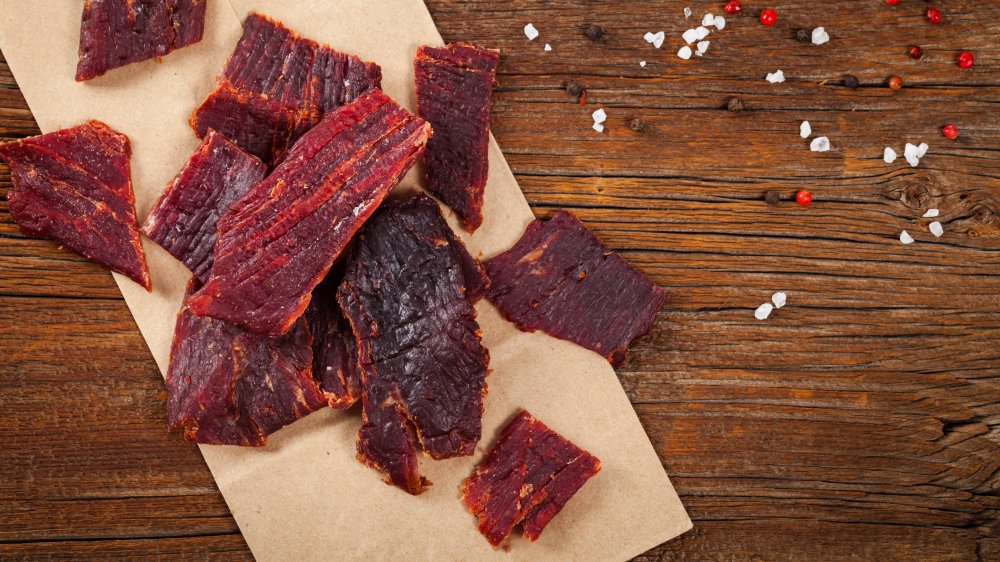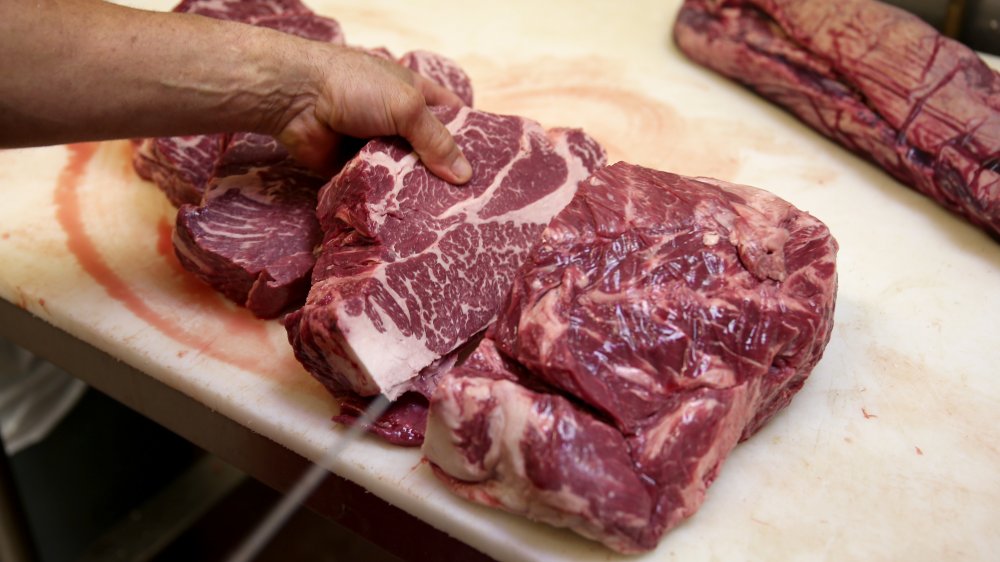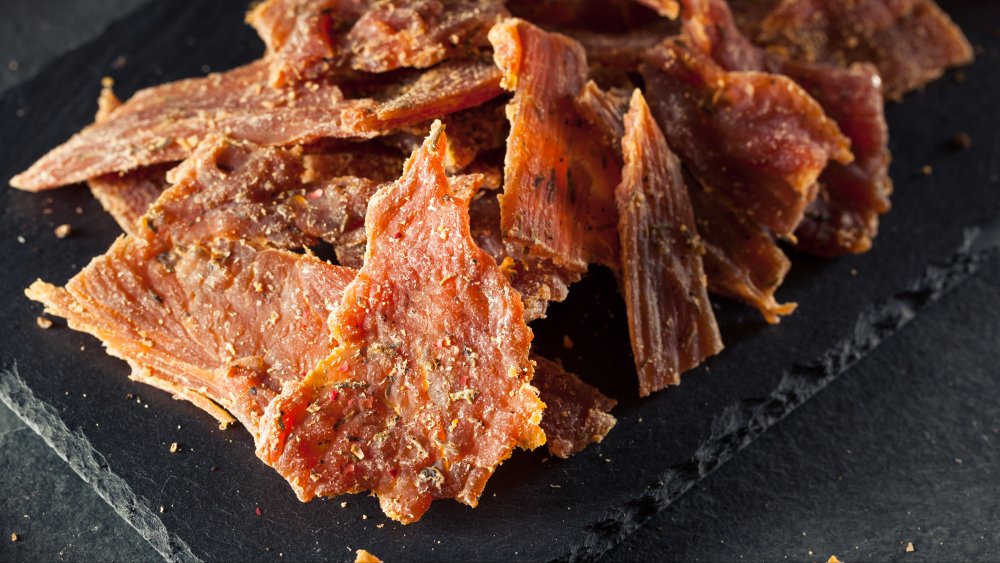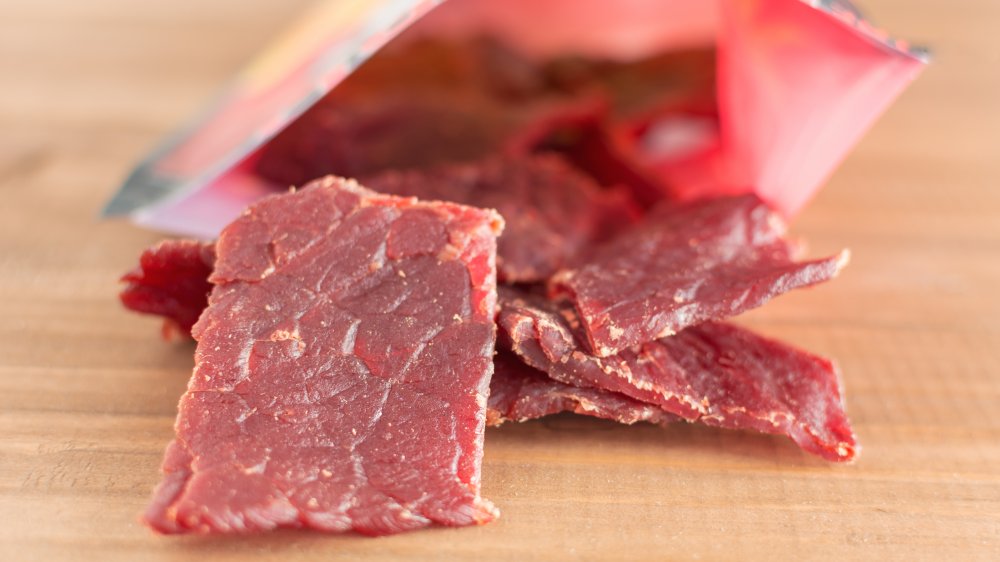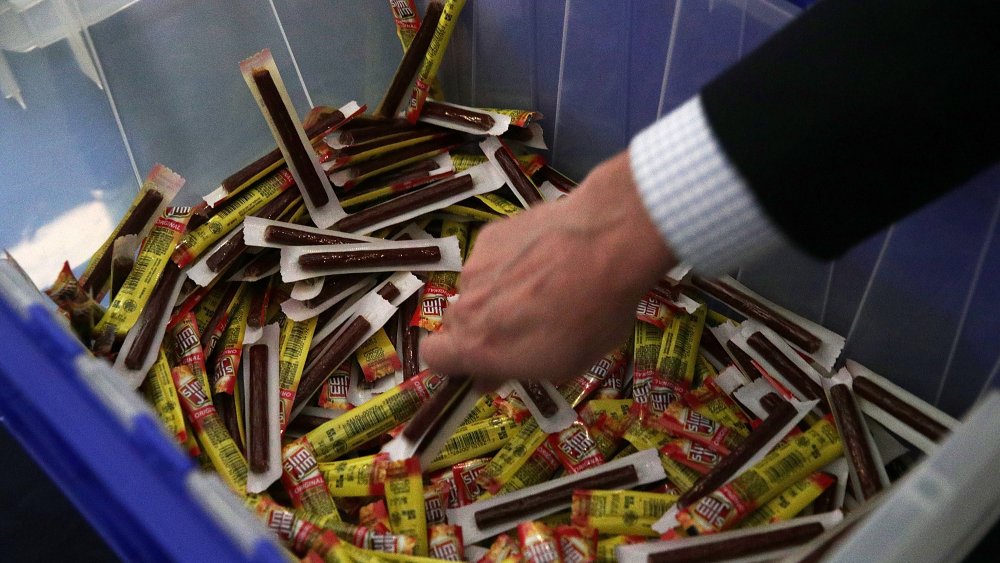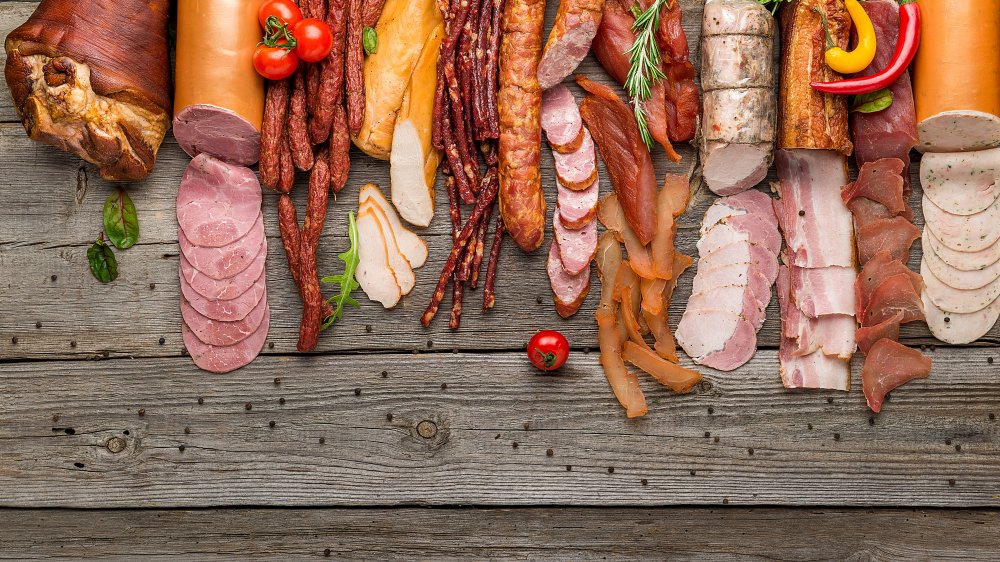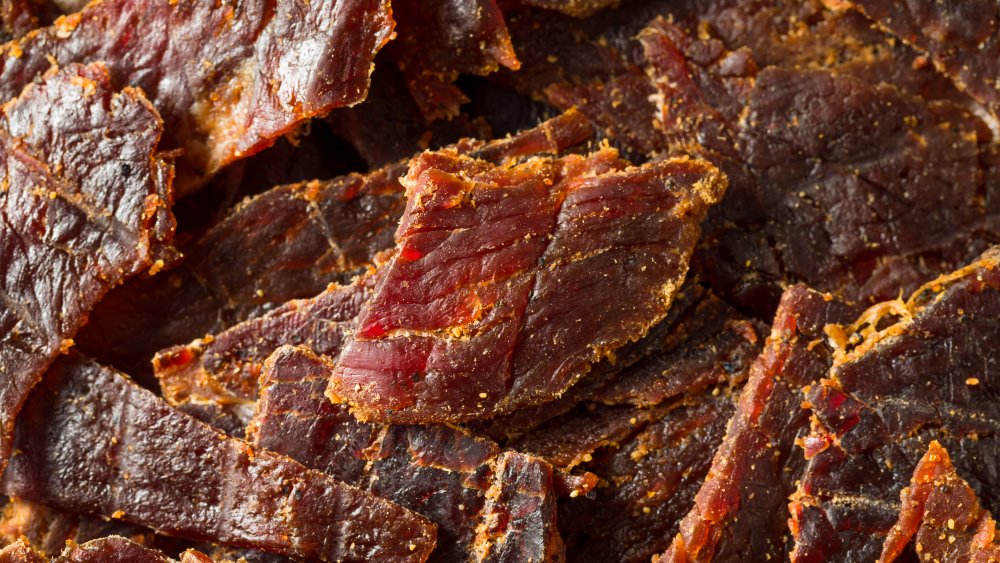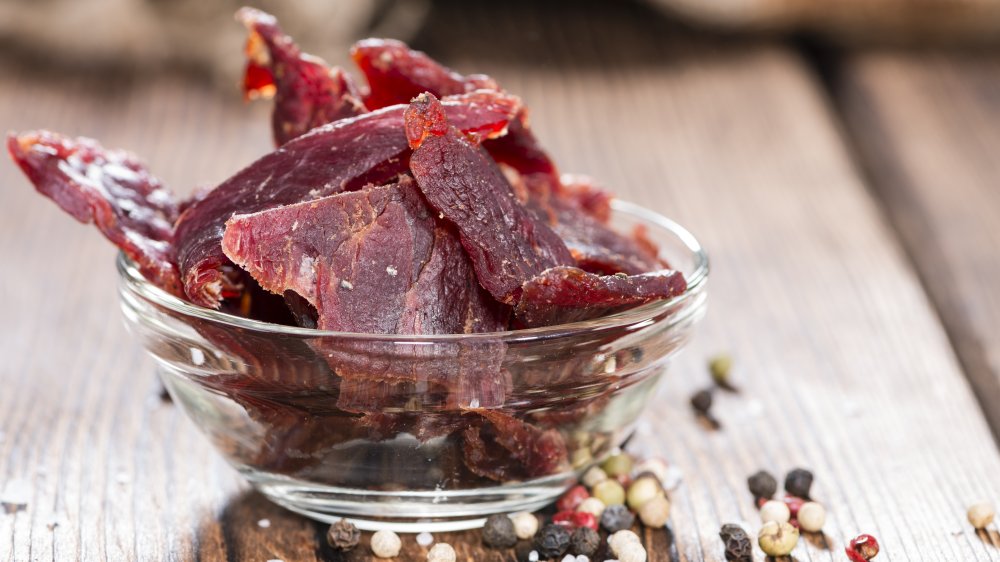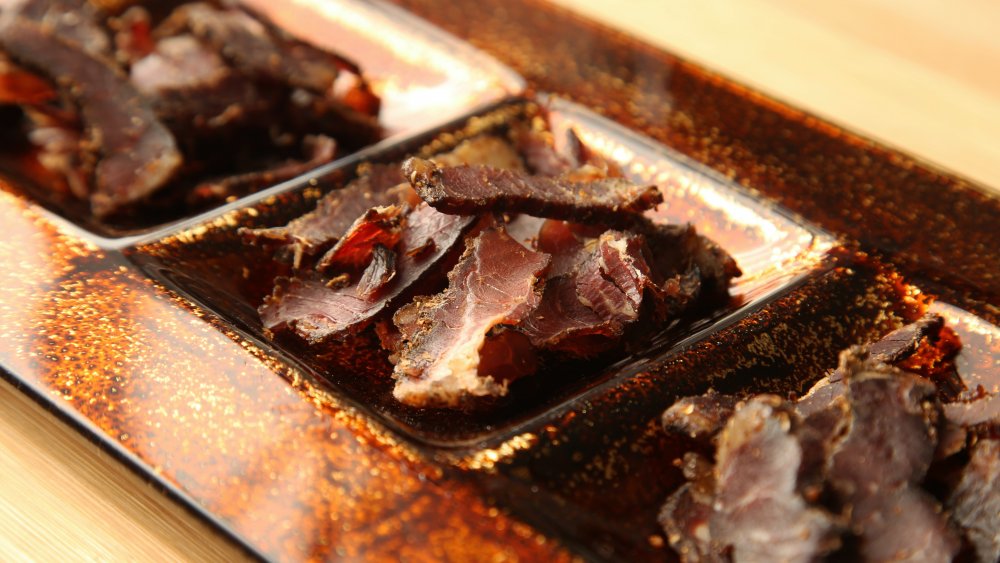What if Beef Jerky Made From
This Is How Beef Jerky Is Really Made
Beef jerky is one of the stranger meat products out there. These days, it's a pretty common gas station food that's vacuum-packed in plastic and sold ready-to-eat. As far as cold-cuts go, it's not exactly the best — but it can make a decent snack in a pinch; even if it does have a bit of a reputation as junk food.
Maybe you're the sort of person who can't help but indulge in a little jerky every now and then. Or, perhaps you've given into jerky temptation just once and desperately want to know what you've just done. Either way, you might want to check out how this stuff is made. The truth is, jerky is unlike most other meats — in a wide variety of ways. From its surprisingly long history, to the ins-and-outs of the production process and the ways you can make it at home, this is how beef jerky is really made.
Beef jerky has been around for thousands of years
Beef jerky — or, at least, its predecessor — has a much longer history than you might imagine. The type of food that eventually became jerky originated in the Americas hundreds of years ago. Depending on who you ask, Ch'arki, which is the Inca language Quechuan's word for "dried meat," was first made either during the Inca empire or by North American Indian tribes, who used buffalo meat in their recipes. Either way, jerky was a compact, easily-transported type of meat that could be made from any animal and was well-suited for long journeys. For the tribes who thrived in the Americas before the colonization, it was a hugely useful way of storing and preserving meat.
When the first Europeans arrived in the Americas, they were taught by the Native Americans how to make their own version of jerky, and before long it had become a favorite snack for European pioneers. During the expansion into North America, it became valued as one of the most important recipes for explorers and colonizers — since they often had to make do without fresh food. Over the next few centuries, food companies began to produce jerky on an industrial scale, and today it's consumed by tens of millions of Americans each year.
The best cuts of meat make the best beef jerky
The first thing you need to do when you're preparing beef jerky is figuring out which cut of meat you're going to use. The good news is that, in this regard, the cow is your oyster — since all kinds of cuts can be used in the production process. The bad news is that the store-bought jerky you somehow got for less than a dollar probably isn't using the choicest cuts.
The golden rule with jerky meat is avoiding fat as much as possible, since using fatty meat runs the risk of spoiling your jerky. The leaner the better, basically. Some of the best cuts of beef for jerky include the eye of round, which is the oval muscle in the rear leg. This cut has little exterior or interior fat which makes it perfect for jerky. Bottom round, meanwhile, is equally lean and, despite being the least tender of the rounds, produces some of the most flavorful jerkies you can get. The top round and sirloin tip are both decent for jerky production, though the latter tends to be more expensive than the former. For a tougher variety of jerky, you can also use flank steak; or ground meat, if you want to go the other way and make softer jerky that's easier to chew.
As for store-bought jerky, the more expensive kinds of jerky are likely to use better cuts of beef. It's as simple as that.
Beef is hardly the only meat that's made into jerky
Although beef jerky is definitely the king of the jerkies as far as popularity is concerned, you can use pretty much any meat you like to make it. Some of the more common varieties include duck jerky, which has a mild and slightly sweet taste and is often marinated in soy sauce. There's also turkey jerky, which is a staple treat during Thanksgiving and even fish jerky, which tends to be higher in protein and Omega-3 fatty acids. These, however, are practically pedestrian compared to some of the jerkies people have concocted over the years.
Take alligator jerky, for example. Often made from alligator tenderloin (yum!), this jerky has a mild taste and a firm texture. There's also alpaca jerky, for anyone who loves an animal that can make cured meat snacks and mohair sweaters. Or how about kangaroo jerky? It's high in nutrients and often seasoned with pepper flavoring. And in case you didn't notice, it's also made from real kangaroo. Kangaroo!
But even that has nothing on rattlesnake jerky. PBFY Flexible Packaging's blog suggests bringing rattlesnake jerky to your next potluck, which, let's be honest, is either a cruel joke or a hilarious punishment.
Either way — who needs cows?
Making beef jerky can be a lengthy process
Let's get down to brass tacks, then: How is beef jerky actually made? The process obviously differs depending on whether you're a huge company mass-producing jerky, or you're making it at home for yourself. Let's start with the industrial stuff.
First, the meat is treated so as to remove any bones or connective tissue it might contain before being defatted. One way of doing this involves spinning it in a large centrifuge so that the liquid fat particles separate from the meat. You can also press the meat to squeeze the fat out. At the same time, a curing solution is produced. Water, salt, seasonings, and other additives are sent into a large tank, where the solution is heated and mixed together.
Next, the meat is either frozen and cut into chunks or ground up using a chopping machine. It's then either dipped into a curing solution long enough that the liquid can fully penetrate it, or the meat is injected with the solution. Either way, the treated meat is then placed into a tumbling device that tenderizes the meat and adds extra quantities of the curing solution. After this process is completed, the meat is molded into blocks and cooled. Finally, the meat is sliced into strips, and these strips are placed onto wire mesh trays, heated up and dried out. This squeezes out at least 20 percent of the meat's moisture and in the end, presto — jerky.
Oxygen is the enemy of beef jerky when it comes to packaging
After the beef jerky has been made, it's then packaged. The best way to store jerky is through vacuum-packing, which ensures the jerky is kept as fresh as possible for as long as possible. One manufacturer, for example, places the meat into a triple barrier bag, fills it with nitrogen, and then seals it. The oxidation process is what makes jerky go bad, so removing the oxygen keeps that jerky fresh. Because vacuum-packing can crumple a bag, however (and because no one likes a shabby product) many companies use oxygen absorbers to remove the oxygen, rather than actually removing the air and creating an immediate vacuum. These absorbers are essentially small packets that contain iron powder. The powder reacts with the oxygen and begins to rust, which diminishes the amount of oxygen in the air. Many brands of oxygen absorber can reduce the oxygen level in a packet down to less than 0.1 percent.
Nowadays, it's also possible to buy jerky in a resealable package, which is vacuum-sealed at first but can be opened and resealed with a ziplock. Neat, huh?
The nitrosamine conundrum of beef jerky
Unsurprisingly, beef jerky tends to contain a few additives and chemicals — and even less surprisingly, some of these might be pretty bad for you.
Chief among these are nitrates. Nitrates are very commonly used in the preservation of cured meats such as jerky, hot dogs, and salami. They're added to these meats in order to give them extra color and extend their shelf lives. While safe nitrates appear naturally in many foods, the artificial ones have been associated with a slew of potential health problems. This is because they set off a chemical reaction that leads to the formation of nitrosamines, a kind of carcinogenic compound that occurs when you combine nitrates and naturally broken-down proteins known as amines. And these chemicals can be pretty hazardous.
For example, a 2018 study by John Hopkins suggested a possible connection between the consumption of artificial nitrates and the mood disorder known as mania. People hospitalized for mania were more than three times as likely to have consumed cured meat at some point in their lives than those who had no serious psychiatric issues. Nitrosamines have also been linked to various cancers.
Don't go thinking artisanal jerkies labeled as "nitrate-free" will do you much good, either. These jerkies simply haven't used the additives sodium nitrite or sodium nitrate to cure the meat. At some point, nitrates or nitrites were still added. In fact, this has to be done for meat to be considered cured.
Beef jerky is full of protein, but it's also heavy in sodium
So, beyond all those nasty nitrates, just how bad for you is beef jerky? Well, there's good news and bad news, here. The good news is that beef jerky is actually a great source of protein. The USDA says that one cup of beef jerky pieces contains a whopping 30g of protein, coming to about 7g per piece. The bad news is that's pretty much where the good news ends.
A single piece of beef jerky contains around 5g of fat, which is usually a blend of saturated and unsaturated fats. Jerky doesn't provide too much in the way of vitamins or minerals either, with only trace amounts of potassium and zinc being present in the meat. It can, however, be a decent source of iron, magnesium, vitamin B12, and choline.
As you might know, jerky is also chock-full of sodium. One cup is likely to contain up to 1870mg of sodium — and considering the guideline daily intake for sodium is less than 2300mg per day, that leaves you looking pretty bad on the ol' salt front. Any doctor will tell you that sodium can cause high blood pressure, increasing your risk of heart attacks, heart failure, strokes, kidney disease, and blindness. Nobody is telling you not to eat jerky, of course — just don't get carried away, and you'll be fine.
There are lots of rules and regulations when it comes to making beef jerky
In the United States, the production of beef jerky isn't subject to the most rigorous of regulations by the FDA. But the production process is monitored by the Department of Agriculture's Food Safety and Inspection Service in all federally-inspected plants, and the government has guidelines to keep the process safe.
Under these guidelines, for example, jerky should be heated to 160 degrees before the dehydrating process to assure that any bacteria will be killed by the wet heat. This is because, according to the FDA, "most dehydrator instructions do not include this step, and a dehydrator may not reach temperatures high enough to heat meat to 160 °F or 165 °F." The danger here is that if the meat isn't cooked at a high enough temperature prior to dehydrating, the bacteria won't be destroyed, and will become heat resistant after the meat is dried.
During the actual drying process, it's also important for producers to maintain "a constant dehydrator temperature of 130 to 140 °F." This process must occur fast enough to dry the food before it can spoil, and has to remove enough water so that bacteria won't grow on the meat.
The FDA has also published guidelines for making jerky at home. These are mostly common sense tips, but the FDA also recommends you take the same step as industrial producers, and cook the meat at 160 degrees before dehydrating it.
There's no shortage of homemade beef jerky recipes
So — how do you make beef jerky at home? Well, the process isn't all that different from how it's done in factories; it just happens on a smaller scale.
Let's take this relatively simple beef jerky recipe from Jerkyholic as an example. Once you've got your cut of beef, the first thing you need to do is trim all of the visible fat. Then, slice the meat. You can either do this with the grain, for a more chewy jerky, or against the grain, if you'd rather it was more tender.
Next, you need to make a cure. This recipe recommends using garlic powder, black pepper, Worcestershire sauce, and habanero peppers, but it's really up to you. Throw your ingredients into ¾ of a cup of cold water, add a little curing salt, sea salt, granulated sugar, and then blend it all up. The resulting marinade should be combined with the jerky slices in a bowl or ziplock bag for anywhere between six and 24 hours.
Once this is done, strain your marinated jerky strips in a colander and dry them with a paper towel. Next, transfer the strips to an oven rack, smoker rack, or a dehydrator tray if you're that fancy. Then dry them out for a few hours (this recipe suggests three) by cooking them at least 165 degrees. FDA rules, remember?
Soon enough, you'll have your very own homemade beef jerky.
If beef jerky isn't your thing, there's also veggie jerky
Of course, one of the defining features of jerky is the meat... since that's literally all it is. Luckily, these days there are plenty of veggie and vegan-friendly recipes out there, and it's entirely possible to get a kick of jerky without having to chew on an animal at the same time.
The process is exactly the same as with beef or any other meat: you slice it, you marinade it, you dry it. But it's possible to use all kinds of substitutes for that meat — eggplant, for example, is great for soaking up the flavor of the marinade. You could try jackfruit, arguably one of the best meat substitutes out there on account of its genuinely amazing meat-like texture. There's tofu, of course, for your retro veggies, as well as portobello mushroom or cauliflower if you're veering more towards actual vegetables.
Honestly, you can use any number of different vegetables and meat substitutes. As with the flavor of the marinade, it's always worth mixing it up and seeing what happens. You never know what you'll stumble across.
Making beef jerky differs from country to country
Although beef jerky might be one of the world's most popular cured meats, it's by far the only one. In fact, a huge range of very similar recipes exists in countries across the globe. Take cecina, for example. This Spanish recipe is made by salt-curing and air-drying beef, and dates back to at least the 4th century B.C. Just like jerky, it can be made from pretty much any animal, although it mostly uses the hind leg of a cow.
The production process is remarkably similar to jerky with the meat cured in salt before being dried and smoked for two to three weeks. All in all, the process takes seven months. It's not identical to jerky (it contains some fat, for example, and tends to be far more tender) but it's certainly not far off.
There's also biltong, a South African delicacy of marinated and air-dried beef. This recipe was brought to South Africa by Dutch pioneers, who needed a hardy food that could sustain them on their journeys inland — which is pretty much the exact same origin story as jerky, just with a few names changed. Today, biltong is enjoyed throughout South Africa as a snack.
So it seems that jerky is anything but unique to the American continent. This snack, or something similar, has cropped up all over the place — often for the exact same reasons that jerky was developed by the Incas and Native Americans.
piguenitlierearmeng.blogspot.com
Source: https://www.mashed.com/210567/this-is-how-beef-jerky-is-really-made/
